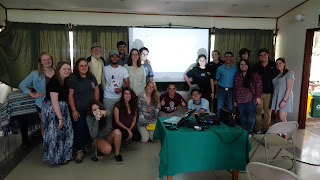Racism in Costa Rica
by Lauren and Brian
This week's presentation was on Racism in Costa Rica. In previous presentations and readings we have discussed that racism in Costa Rica did not present much of an issue as it has in the development of other countries. We learned that there was substantial racial mixing that had occurred during the nation's formation and colonization periods that resulted in mulatos and mestizos making up the majority of the population. This resulted in social divisions being mainly based off of socioeconomic status instead of race like other countries. However, this presentation presented another side of Costa Rica's history that showed that in reality the country does have a history of racism. For example, the discussion revealed that racism was present against Africans, Nicaraguans, and the indigenous people. In the 20th century there came the notion of "our blood is blackening" from Costa Rican scientists and a desire for a "white" Costa Rica took root. Costa Rican people also came to resent both Africans and Nicaraguans due to the United Fruit Company. While the Costa Rican government required foreign corporations to hire a certain percentage of Costa Rican workers, the United Fruit Company circumvented this by forging residency documents for both African and Nicaraguan immigrants. As a result, the United Fruit Company was able to pay them lower wages and the Costa Rican people were left unemployed. The indigenous people of Costa Rica have also been victims of racism in Costa Rica's past. In 2000, only 1.7% of the population identified as indigenous showing how stigmatized and depleted the indigenous population has become in Costa Rica. According to the Tico students, there are now programs in schools that 1) enable indigenous children to learn in their native tongue and 2) celebrate indigenous cultures through art workshops and the like.
As a result of this presentation, further discussion ensued that grappled with our previous understanding of Costa Rica as being more racism free versus the racism against Africans, Nicaraguans, and indigenous people showcased in this chapter. In the end we decided that the first statement could describe the early development of Costa Rica--the 17th-19th centuries mostly during colonization. In contrast the final part of the statement describes the 20th century. For example, during the colonization period of Costa Rica, most social divisions were based off of socioeconomic status because the majority of the population was mixed race. In contrast, during the 20th century, other races and nationalities began entering the country causing a more racist social situation to arise. Additionally, we discussed the Costa Ricans attitude towards the Chinese who had been brought in during the 1900s to help build the rail road on the Pacific side of the country. Since this time the Chinese government has continued to support "projects" in Costa Rica such as the National Soccer Stadium that was constructed between 2009 and 2011. Instead of using a Costa Rican work force that would have helped fuel the local economy, a cheaper Chinese labor force was brought into the country. When we asked the Tico students if prejudices still existed today between Costa Ricans and the Chinese, Nicaraguans, Africans, and indigenous peoples, they replied that there was the most amount of prejudice between Costa Ricans and Nicaraguans. This has definitely given us more information to ponder as we continue to interact with the local community here in Monteverde.
